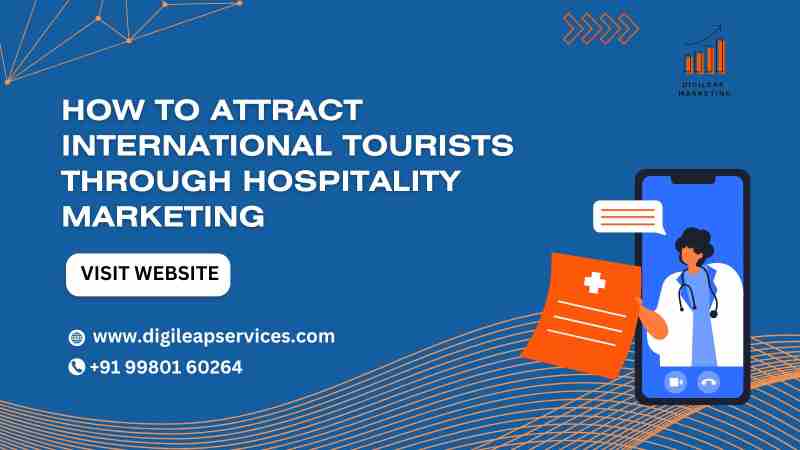Marketing
How to Attract International Tourists Through Hospitality Marketing

Introduction
Let’s be honest—every hotel dreams of being on a traveler’s bucket list. But in today’s digital-first world, dreaming isn’t enough. You should be different, speak the language of travelers, and show up where they look. That’s where International Tourism Marketing comes in.
Today, it’s not enough to rely on shiny ads or stock photos of happy guests. Travelers now want experiences that are personal, local, and genuine. According to Statista.
In 2024, the tourism sector contributed a massive 9.1% of global GDP, a testament to how the sector has recovered in full strength.
How do hotels, resorts, and destinations get a piece of that enormous pie? Through the right combination of social media marketing, tourism branding, and customer-first storytelling, let’s explore what really attracts international guests in this new era of travel.
1. Understanding Today’s Traveler in International Tourism Marketing
The modern traveler doesn’t just want a bed—they want a story. They’re scrolling through Instagram for inspiration long before they hit “book now.” In international tourism marketing, that means meeting them where they already are—online.
Travelers no longer just want luxury but want connection too. The eco-conscious Gen Z backpackers want the perfect getaway; millennial remote workers have another need. A study by Booking.com.
According to the data, 71% of travelers prefer destinations that meet their personal values, like sustainability, culture, or...
This is why understanding audience intent is key. Don’t just show your space; show why it matters and how it makes guests feel. Show experiences, a local story, or a cultural touch that goes beyond “room and breakfast.”
2. Storytelling & Social Media in International Tourism Marketing
If you think “likes” don’t matter, think again. Social media is now the first stop in travel planning. Social media marketing is a cornerstone of international tourism marketing because travelers trust visuals, reviews, and content from real people over advertisements.
Consider Marriott’s TravelBrilliantly effort. Instead of simply advertising lodging, they asked travelers to shape their journeys alongside them. This participation fueled its widespread appeal.
Smaller hotels? Absolutely, they can do this too. Show what goes on backstage, tell quick tales about guests, or team up with popular people online who understand who you’re trying to reach. Real is always better than flawless.
Good marketing isn’t salesy; rather, it mirrors a real chat. Companies such as Digileap assist brands in making their content feel personal so they can genuinely reach people worldwide.
3. Leveraging Cultural Appeal in International Tourism Marketing
Want travelers to fall in love with your brand? Make them fall in love with your culture.
Hotels become unforgettable through stories, particularly within global tourism, where people seek genuine culture. For instance, Taj Hotels focused on feeling, history, alongside kindness - not just expense - with their “Tajness” approach.
Okay, but what does this look like in practice?
- Showcase what makes your community special - the artists, the flavors, the customs passed down through generations.
- Help your team share experiences, rather than simply offer help.
- Host events - workshops, maybe even full-on adventures - that genuinely feel like they belong where you are.
This cultural connection isn’t just marketing—it’s brand building. As one hospitality strategist once said, “People may forget the price of a room, but they never forget how a place made them feel.”
4. Embracing Technology & Trends in International Tourism Marketing
Let’s talk tech. Tech shifts how people find places to go, offering everything from customized suggestions to online explorations. The virtual travel sector could reach $24 billion by 2030 (says Statista), demonstrating that these digital adventures complement actual trips.
Travel companies, alongside destination promoters, now grab the eyes of globetrotters by employing things such as augmented reality or clever chat assistants driven by computers. They’re making planning seamless and experiences richer.
But it’s not just about gadgets. Sustainability is another major trend shaping International Tourism Marketing. Eco-friendly stays and carbon-neutral operations are not just buzzwords—they’re decision drivers. A simple “green initiative” page on your website can make all the difference when travelers are choosing between you and a competitor.
5. Building Loyalty Through Connection in International Tourism Marketing
Attracting tourists is one thing; keeping them is another. Customer engagement is where long-term success lies. Your Facebook ad campaign cannot attract as many travelers as your loyal clients turning to brand advocates can.
By using travel marketing strategies to connect with guest post-check-out, personalized follow-up emails, loyalty rewards, or digital postcards thanking them for their visit.
Digileap’s expertise comes in appropriate yet again when it helps hospitality brands with data-oriented strategies for converting one-time visitors to repeat guests. Combining an emotional connection with smart analytics helps brands stay on consumers’ minds long after the holiday.
6. Collaborations & Partnerships in International Tourism Marketing
No brand grows in isolation. Savvy hotels connect with others—airlines, bloggers, guides—expanding their reach while building credibility. When a hotel works alongside a nearby coffee shop or artist studio, visitors sense genuine character. These connections create opportunities across distances. Tourism partnerships build memories beyond price tags. It’s remarkable what unfolds when visitors encounter a cohesive narrative—linking places, traditions, and individuals into one lasting trip.
Conclusion
The hospitality game has changed. It isn’t designed; it’s a story that helps to convert into a world of infinite options. Brands that creatively blend authenticity, innovation, and emotional depth are mastering international tourism marketing.
Using storytelling on Instagram, AR tours, and sustainable travel will help you create experiences that are ones to save and tell.
Ready to elevate your global reach? Explore Digileap’s digital marketing services
and discover how your hospitality brand can attract travelers from every corner of the world.
TL;DR: Quick Takeaways
- Today’s explorers seek genuine experiences - journeys that respect our planet.
- Relay genuine stories through people others trust; collaborate with those who have an audience.
- Tap into what makes a place unique—it fosters feelings of belonging.
- Catch eyes by embracing new technology—virtual visits, artificial intelligence, and, moreover, green practices.
- Keep guests feeling valued even after they leave—don't just disappear once their stay ends.
Source:
Click for the: Full Story
You might like













 Close Menu
Close Menu